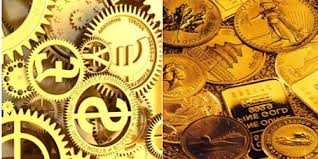For millennia, gold, and to a lesser extent silver, underpinned the value of money—at first directly through the stamping of gold coins, then indirectly with fiat currency “collateralized” by government gold holdings through guaranteed convertibility at a fixed rate. And, throughout history, the dominant international currency has tended also to be the domestic currency of the strongest economic and geopolitical power, which had the military force and the wherewithal to provide “global public goods” – freedom of navigation, enforcement of contracts and rules of international commerce, finance and relations between states; wealth to support its currency as a store of value; and extensive global trade links underpinning the use of its currency as a means of payment.
The leading country typically had also a technological edge, supporting both military and economic leadership, which was often deployed to protect commercial, financial and geopolitical stability. The leading power thus offered what is known as “hegemonic stability” and generally presided over periods of peace—such as Pax Romana, Pax Britanica and, following WWII, Pax Americana.
Despite external challengers and internal debt dynamics, the USD still dominates global capital markets investments and cross-border payments
The recent backlash against the USD has arisen more for geo-political rather than economic reasons. The size and complexity of US capital markets towers over other countries with high levels of both public and private investment in USD financial assets. And, while the US share of global trade has declined, the USD still represents about half of all cross-border payments facilitated by SWIFT.
The attempts to unseat the USD have been more political or opportunistic than economic in nature and no alternative to the USD yet exists. Russia responded to the suite of sanctions by not only seeking to diversify into other currencies including monetary gold but also by advocating for an alternative BRICS' currency. As this has floundered, China and other countries have continued to diversify reserves into gold as a protective measure. The ECB has taken a different approach, seeing in the recent decline of the USD an opportunity for the Euro’s role as a global currency to strengthen but faces strong headwinds.
Supplanting the role of the USD is not imminent as the Chinese government does not necessarily want to cede control over its currencies and European national governments do not have political support to cede further control to the EC. While China is successfully ramping up the use of its currency for bi-lateral trade settlement, the use of the RMB as a global currency would entail freedom of capital flows and the running of balance of payments deficits, neither desired by the government. Europe has no such restrictions on capital flows but suffers from a fragmentation of financial markets and fiscal authority. And, while the ECB expects to launch a central bank digital currency (CBDC) in the near future, this is more likely initially to be used in intra-European trade than between two third-party countries. Finally, the BRICS currency initiative collapsed due to lack of consensus and support amongst its members.
US tensions from both external and internal forces have thus been diverted to the gold market as reflected in its unprecedented rise in price since the USD was delinked from gold
The USD was, arguably, the first global currency untethered from a precious metal and held solely on the basis of trust in the issuing country. Trust in the USD was first tested in 1971, when President Nixon severed the convertibility of the USD to gold in the face of a level of foreign claims that exceeded the domestic gold stock. From 1971 to 1973, the gold price increased from $40/oz in 1971 to $108/oz as the price adjusted to underlying demand and supply variables. Since, the USD regained and until now, has retained the world’s trust based on the “full faith and credit” of the US, despite intermittent challenges and corrective actions.
The gold price run-up since 2022, however, may be signaling a pivot in the existing international monetary system and the start of a transition, albeit gradual, from a US-centric to a more multi-polar system. The recent price rise coincided with the Russia invasion of Ukraine and subsequent severing of a large part of Russia’s access to its USD and EUR foreign currency reserves, as well as to the western led financial system, including the SWIFT global payments system. Subsequently, the new Trump Administration reversed the US government’s traditional support for a free global trading system, multi-lateralism and a strong dollar, weakening the currency and contributing to demand for gold. Finally, the Administration has shown ambivalence to the US traditional role as “keeper of the peace”. These actions have spurred both central bank purchases of gold to diversify foreign currency reserves and private investor interest to protect against the risk of tariffs and, potentially, stagflation.
Private investment demand for gold has also increased, partly due to concerns that a global increase in tariff barriers could lead to “stagflation”-- an economic scenario in which gold vastly outperformed other financial asset classes over the past half-century. Demand for gold Exchange Traded Funds (ETFs) spiked following Trump’s “Liberation Day” announcement on April 6th and has remained largely sustained throughout July, with a net outflow in May coinciding with the announcement of a China-US “entente”, which has yet to come to fruition in concrete terms.
